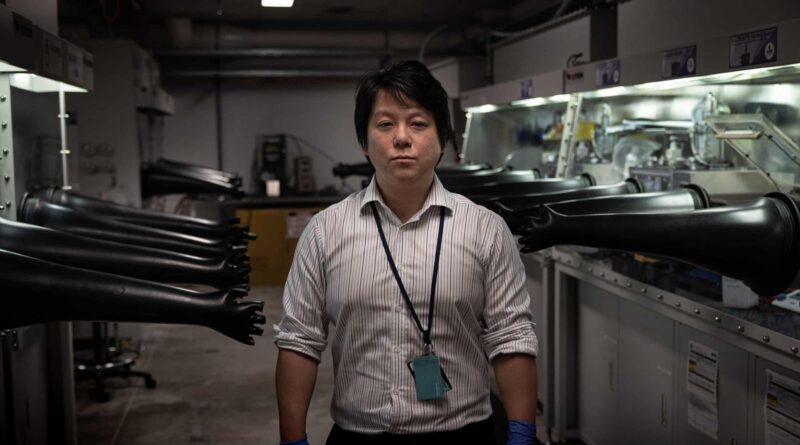Solid-state batteries: inside the race to transform the science of electric vehicles
Working in the dry room at Deakin University’s Battery Research and Innovation Hub is no day at the beach.
“[It’s] more desert than beach,” says its general manager, Dr. Timothy Khoo. “At the beach, you at least still get the moisture coming in.”
The 150-m2 dry room is, as far as Khoo knows, the largest in Australia for research purposes and essential to prototyping and testing the next generation of batteries.
“It’s very difficult working in there for extended periods,” Khoo says. “It’s not dangerous,, but your eyes start getting dry, your skin starts getting dry,, and it feels like you’ve been outside in the sun all summer.”
The room must be dry because water, moisture,, and humidity are lethal to a battery during production. Contamination, Khoo says, means it might not work or that that its performance will be compromised.
Depending on the materials, the worst-case scenario can also be dangerous.
“Lithium reacts poorly with water,” Khoo says. “I don’t know if you ever did high school science, but it’s in the same sort of chemical category as sodium, potassium—if you’ve ever thrown sodium into water, it explodes. It’s a similar reaction in the context of lithium metal.”
Most will be familiar with the lithium-ion battery, first commercialised by Sony in the 1990s to power its portable music players. From these humble beginnings, the rechargeable lithium-ion battery is now king, powering mobile phones, laptops, and, in their most high-performance applications, electric cars.
One McKinsey analysis suggests the global lithium-ion battery market will grow into a $400 billion industry by 2030. But with lithium-ion technology well understood, those seeking transformative change are increasingly looking to solid-state batteries.
Hype and hope
Dr. Rory McNulty, a senior analyst with Benchmark Minerals Intelligence, says the hype around solid-state batteries has been building since the first commercial solid-state battery was introduced by French company Blue Solutions in 2015.
Their battery was designed for use in e-buses but had design limitations and a charging time of four or more hours—an illustration of how difficult the development process can be, even for a company such as Toyota.
Last July, the global car giant announced a breakthrough in the development of solid-state batteries that it claimed would halve the size, weight, and cost of their manufacture.
This was greeted with both excitement and scepticism, owing in part to Toyota having poured money into the development of solid-state batteries since 2006 and its reluctance to commit to producing fully electric vehicles over the past decade.
This development was soon followed by another in October: Toyota and Japanese petroleum company Idemitsu said they were aiming to develop and manufacture a solid-state electrolyte and bring it to market by 2028.
Toyota isn’t the only company working in the area. In January, Volkswagen announced that successful testing on a solid-state battery developed by QuantumScape achieved more than 1,000 charging cycles and maintained 95% of its capacity.
Meanwhile, Chinese companies such as WeLion and Nio EV have partnered to rush out a solid-state battery—albeit one with less ambitious chemistry—by 2024, but McNulty says those in western countries will have to wait until the end of the decade.
“Toyota has pushed back its solid-state delivery timeline a few times over the years, which I think is a testament to how difficult some of the technical challenges that underpin the development of a novel technology can be,” he says.
Battery mechanics
The basic promise of solid-state batteries is more energy generated by a smaller battery. Efforts to develop the technology have taken several approaches, but Khoo says much public attention is focused on two materials: silicon and lithium metal.
“Silicon-based anodes are a little more advanced in terms of their technological readiness than lithium-metal-type batteries,” he says. “Purely from a scientific or engineering perspective, I believe lithium-metal batteries are a little more revolutionary.
“That is, if people can get them to work.”
Broadly speaking, there are three components that make a battery: a cathode, an anode, and an electrolyte. From a scientific or engineering perspective, Khoo says the anode, commonly known as the “negative” side of a battery, releases electrons into a circuit; the positive side, the cathode, receives the incoming electrons. The electrolyte allows ions to transfer between them.
The interaction of these components gives a battery its “energy density”—the amount of energy it can hold relative to its weight. Higher-density batteries hold more charge, which makes them suited to things like electric cars.
Unlike current lithium-ion batteries, which use a graphite-silicon anode with a liquid electrolyte, solid-state batteries, as the name implies, swap the liquid for a solid material.
This creates a safer battery as there is no risk the liquid will leak if the casing is punctured, as in a car accident, and the chance of lithium fires is reduced. More importantly for EV drivers, it promises vastly improved range.
But for all the hype, the development of solid-state batteries is being held back by the anode.
Dendrites and development
Of the several variations out there, lithium-metal anode solid-state batteries have received significant attention as a potential high-performance future battery technology.
The catch? Developing them has run into a problem known as “dendrites.”.
Dendrites form when lithium ions “plate” on to the pure metal anode, leaving tiny spurs on the surface.
Lee Finniear, the chief executive of Li-S Energy and a founding director of the Advanced Materials and Battery Council, says that as these imperfections grow over time, they act “like the high point on a building in a major city during a lightning strike.”
“The lithium ions are trying to find the shortest path to the anode,” he says. “If you get any variation or any kind of high point on the anode, it will tend to attract more ions, which will then plate as lithium, increasing the high point.”
Depending on how big these dendrites grow, they can pierce the material, separating the anode from the cathode, and cause a short-circuit.
“And that kills the battery,” he says.
There are other challenges too, but solving these problems can be difficult and expensive, which is why others have preferred to work with silicon anodes, which rely on a similar material to that used in photovoltaic solar panels.
As it is highly conductive, it is thought that the more silicon that’s used in an anode, the more its performance will improve.
Silicon anodes act like sponges, soaking up water and expanding and contracting with each charge cycle. Adding more silicon increases how much the anode expands, and a pure silicon anode can expand up to four times its size.
Without intervention, the anode will eventually pulverise itself.
One fix involves structuring the silicon in a special way; another is to find additives to change its behaviour.
It is possible to solve these problems, but making these batteries commercially available for use in EVs remains difficult.
As a result of future technologies, manufacturing lines will have to be rebuilt and supply chain issues resolved, particularly as no one is currently producing enough pure lithium-metal foil to supply car battery manufacturers.
Any breakthrough that addresses these problems and brings down the cost of production for solid-state batteries would be revolutionary, but Toyota has so far been coy about the materials it is working with in its anodes.
When asked, a Toyota Australia spokesperson said they could not disclose this as “research and development is being undertaken by its parent company.”.
Whatever the case, industry figures privately say it is best to simply assume the company is pursuing “everything.”.
“People forget that we’re talking about science here,” Finniear says. “We’re talking about persuading electrons, ions, and chemicals to do what they’re told; it’s not software development; it’s not something you can program your way through.
“These breakthroughs are really important, but they take a lot of work.”
Source : theguardian.com




